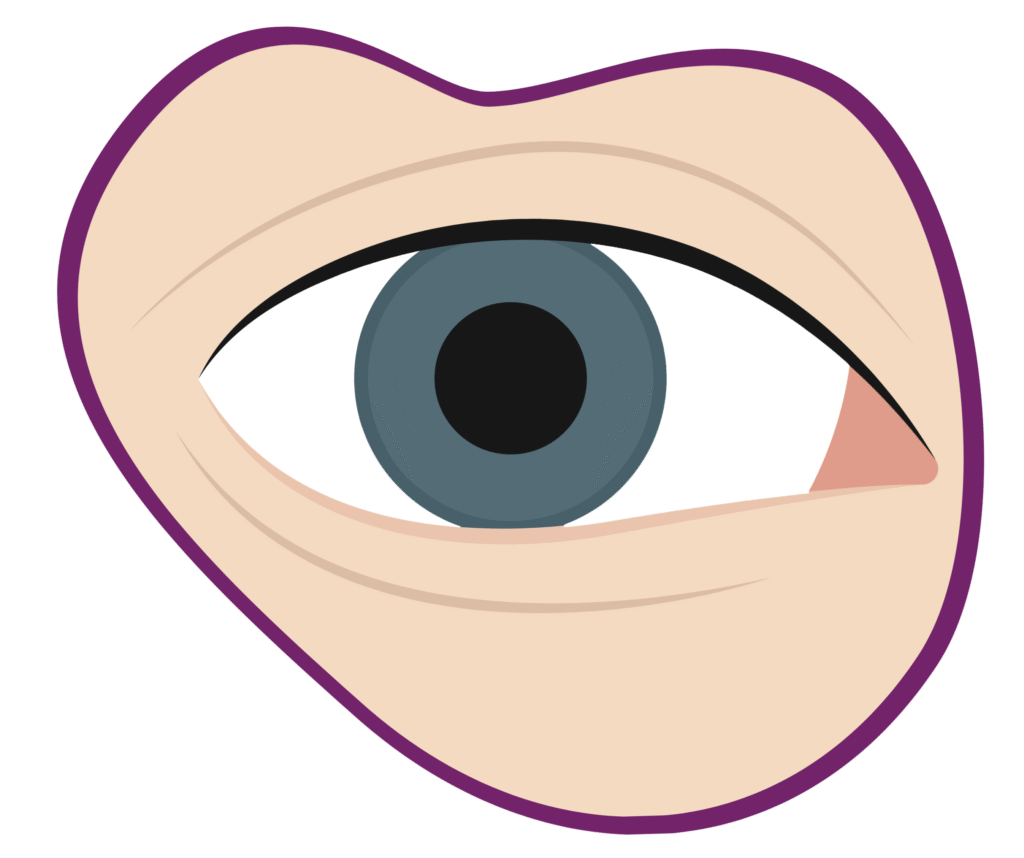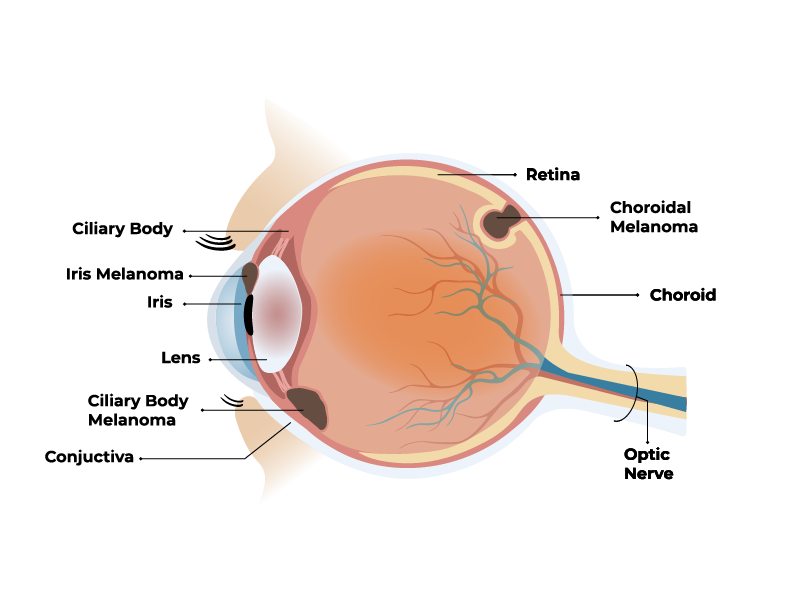
Uveal Melanoma
Uveal melanoma is a type of ocular melanoma that forms in pigment-producing cells in the middle layer of the eye.
You can find further information about the anatomy of the eye on the About Ocular Melanoma webpage.
This page introduces you to uveal melanoma, its symptoms, and some of the treatment options that may be available to you in the UK.
Page navigation
What is uveal melanoma?
Although rare, uveal melanoma is the most common type of ocular melanoma.
These melanomas form in the pigment-producing cells in the middle layer of the eye. You can learn more about the structure of your eye on the About Ocular Melanoma page.
Because uveal melanomas occur in the iris, ciliary body, or choroid, they are also sometimes called iris melanomas, ciliary body melanomas, or choroidal melanomas.

Symptoms of uveal melanoma
Uveal melanomas don’t always cause symptoms. Because of this, these cancers are often found during a routine eye test.
But sometimes, you may visit your optician or optometrist because you are experiencing:
- Blurred vision
- Seeing shadows
- Seeing lights
- Seeing floaters
- Pain in the eye (rare)
Other common conditions can also cause these symptoms. It is important to have regular eye tests and have any changes to your vision checked by your GP or optometrist.
Treatments for uveal melanoma
Different treatment options are available for people with uveal melanomas.
To work out the best treatment for you, your doctors will look at several factors, including:
- The type of ocular melanoma you have
- The size and position of your tumour
- How thick the tumour is
- Whether the cancer has spread
- Your overall age and health
Your medical team will explain your treatment options and side effects, and help you make treatment decisions.
Radiotherapy
Radiotherapy is one of the main treatments for uveal melanomas. Radiation stops the cancer cells from growing or making more cancer cells, causing the tumour to shrink and be destroyed.
In the UK, you are most likely to receive plaque radiotherapy or proton beam therapy for uveal melanomas. In some cases, stereotactic radiotherapy may also be offered. There is no single best form of radiotherapy for eye cancers — each has its benefits and risks, including side effects.
Depending on your circumstances, your doctor will suggest the best options for you.
Plaque radiotherapy (sometimes called plaque brachytherapy)
When you undergo plaque radiotherapy, a small, thin metal disc is temporarily attached to the surface of the affected eye, overlying the cancer cells.
If this treatment is offered to you, you will stay in the hospital for around a week and have two surgeries on your eye:
- The first surgery is to attach the plaque to your eye
- The second surgery takes place a few days later, to remove the plaque before you are discharged.
Your doctor will perform both operations under anaesthesia, so you should feel no pain or discomfort during the surgery.
Your medical team will tell you more about what to expect before you start treatment.
Proton beam therapy (or PBT)
Proton beam therapy uses an external machine to deliver a beam of radiation directly to the cancer in your eye.
You will need an operation around a month before your radiation treatment, to attach small tantalum (an inert metal) markers on the eye near your tumour. They mark the treatment area and help your doctor direct the PBT therapy to your cancer.
For this operation, you will usually stay in the hospital for around a day, and then go home to recover.
Before starting radiation treatment, you must also attend an assessment and planning visit at Clatterbridge Oncology Centre. You will receive your treatment at the Centre, usually a couple of weeks later. Treatment is given in doses over a few days, with each daily treatment taking up to an hour.
Proton beam therapy is painless. Your medical team will tell you more about what to expect before you start treatment.
Stereotactic radiotherapy
Stereotactic radiotherapy uses special equipment to deliver radiation directly to the cancer in your eye. The machine used to deliver treatment is sometimes called a “GammaKnife machine”.
Stereotactic radiotherapy is only offered via the Sheffield Ocular Oncology Service and is not suitable for everyone. It is especially useful for people who are unable to undergo an operation or prefer to have their treatment completed in a single day.
Learn more about stereotactic radiotherapy and its side effects on the Sheffield Teaching Hospital’s website.
Surgery
In some cases, surgery may be required to treat uveal melanoma.
Local resection
Although this is rare for uveal melanomas, you may get surgery to remove your tumour and a small amount of tissue surrounding it.
A local resection is not always possible. Your doctor will be able to tell you more if this is an option for you.
Enucleation
Enucleation involves the removal of your affected eye to remove the cancer within it. Your doctor may recommend it as a first option if your tumour is too large for other treatment options.
Sometimes, enucleation is recommended if treatment with radiation is not successful.
Your surgery will be performed under anaesthesia. You may either be given a general anaesthetic, where you are completely asleep during surgery, or a local anaesthetic with deep sedation, where you are very sleepy but not totally asleep.
In both situations, you should feel no pain or discomfort during surgery.
Your care team will also be able to answer any questions you have about this surgery.
Other treatment options
The treatment options below are sometimes suitable for uveal melanomas.
You can ask your doctor for more information regarding these treatment options.
Photodynamic Therapy
Photodynamic therapy uses a combination of injected dye and laser to treat tumours.
First, you will be given a drug that sensitises your cancer cells to light. Then, your doctor will shine a laser on the cancer cells, thus destroying them.
This treatment may be used to treat small uveal melanomas.
Watch and wait
Sometimes, doctors may not be sure that what you have is cancer. They may recommend the watch-and-wait approach (also sometimes called watchful waiting or observation).
During the waiting period, eye checkups may be recommended every 3-4 months to monitor any growth. A treatment plan will be made if your medical team detect evidence of cancer.
Your cancer could also be slow-growing and not require treatment immediately. In these cases, your doctor may recommend the watch-and-wait approach before starting treatment when it becomes necessary.
Follow-up care
Treatments for uveal melanoma are effective, but can cause side effects like soreness, dryness, inflammation, and ‘changes to your vision’. You may wish to discuss potential side effects with your care team and how best you can manage them.
After your treatment, your medical team will also make a plan for you to have regular check-ups or scans to monitor changes to your eye.
This regular imaging is done to make sure everything after treatment is going well. They are arranged so that any changes to your eye are caught early.
Depending on your cancer type, you may also be offered scans for other parts of your body, like your liver. These are called surveillance scans.
If you are worried about having regular or surveillance scans, have related questions, or have any new symptoms, speak to your medical team. They can guide you.
You can also contact us to talk through what is on your mind and how you can find answers to your questions.
Contact us for support
The Ocular Melanoma UK support line offers confidential support to people living with Ocular Melanoma and their loved ones.
Call us on 0300 790 0512
Lines are open Monday – Friday
Email us
Get in touch with us via the form linked in this button here
